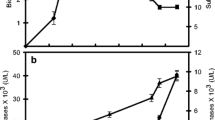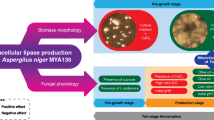Summary
High concentration production of an extracellular enzyme, lipase, was achieved by a fed-batch culture of Pseudomonas fluorescens. During the cultivation, temperature, pH and dissolved oxygen concentration wwre maintained at 23°C, 6.5 and 2–5 ppm, respectively. Olive oil was used as a carbon source for microbial growth. To produce lipase effectively the specific feed rate of olive oil had to be maintained in a range of 0.04–0.06 (g oil) · (g dry cell)-1 · h-1. The CO2 evolution rate was monitored to estimate the requirement of olive oil. The ratio of feed rate of olive oil to the CO2 evolution rate was varied in the range of 20–60 g oil/mol CO2. The higher value of the ratio accelerated microbial growth, but did not favour lipase production. Once the high cell concentration of 60 g/l had been achieved, the ratio was changed from 50 to 30 g oil/mol CO2 to accelerate the lipase production. By this CO2-dependent method a very high activity of lipase, 1980 units/ml, was obtained. Both the productivity and yield of lipase were prominently increased compared with a conventional batch culture.
Similar content being viewed by others
References
Alford JA, Pierce DA (1963) Production of lipase by Pseudomonas fragi in a synthetic medium. J Bacteriol 86:24–29
Arima K, Tamura G, Narasaki T, Nakamura H, Saiki T (1966) Japanese Patent 41-7836
Fujita T, Yamashita H (1986a) Japanese Patent 61-289883
Fujita T, Yamashita H (1986b) Japanese Patent 61-289884
Hoq MM, Tagami H, Yamane T, Shimizu S (1985a) Some characteristics of continuous glyceride synthesis by lipase in a microporous hydrophobic membrane bioreactor. Agric Biol Chem 49:335–342
Hoq MM, Koike M, Yamane T, Shimizu S (1985b) Continuous hydrolysis of olive oil by lipase in microporous hydrophobic hollow fiber bioreactor. Agric Biol Chem 49:3171–3178
Narasaki T, Tamura G, Arima K (1968) Studies on the lipoprotein lipases of microorganisms part II. Effects of culture conditions on the production of lipoprotein lipases by Pseudomonas sp. M-12-33. Agric Biol Chem 32:1453–1457
Sugiura M, Oikawa T, Hirano K, Inukai T (1977) Purification, crystallization and properties of triacylglycerol lipase from Pseudomonas fluorescens. Biochim Biophys Acta 488:353–358
Sugiura M, Oikawa T (1977) Physicochemical properties of a lipase from Pseudomonas fluorescens. Biochim Biophys Acta 489:262–268
Suzuki T, Mori H, Yamane T, Shimizu S (1985) Automatic supplementation of minerals in fed-batch culture to high cell mass concentration. Biotechnol Bioeng 27:192–201
Suzuki T, Yamane T, Shimizu S (1986a) Mass production of poly-β-hydroxybutyric acid by fully automatic fed-batch culture of methylotroph. Appl Microbiol Biotechnol 23:322–329
Suzuki T, Yamane T, Shimizu S (1986b) Control of carbon source supply and dissolved oxygen by use of carbon dioxide concentration of exhaust gas in fed-batch culture. J Ferment Technol 64:317–326
Author information
Authors and Affiliations
Rights and permissions
About this article
Cite this article
Suzuki, T., Mushiga, Y., Yamane, T. et al. Mass production of lipase by fed-batch culture of Pseudomonas fluorescens . Appl Microbiol Biotechnol 27, 417–422 (1988). https://doi.org/10.1007/BF00451606
Received:
Accepted:
Issue Date:
DOI: https://doi.org/10.1007/BF00451606




